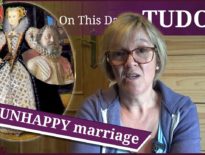On this day in Tudor history, 23rd March 1540, Waltham Abbey, an Augustinian house in Essex, was surrendered to the Crown. It was the last abbey to be dissolved in Henry VIII and Thomas Cromwell's dissolution of the monasteries.
Find out more about this historic abbey, its origins and what's left today, and also who profited from its lands, in today's talk.
Here's a link to the English Heritage page on Waltham Abbey Gatehouse and Bridge to see photos of it and to find out more about visiting it - https://www.english-heritage.org.uk/visit/places/waltham-abbey-gatehouse-and-bridge/
Also on this day in Tudor history, 23rd March 1534, the Pope issued a bull proclaiming Catherine of Aragon to be England's true queen and Mary the heir to the throne, while the English Parliament declared Anne Boleyn to be England's rightful queen and her daughter, Elizabeth, the heir. Find out more about this strange situation in last year’s video:
Also on this day in history:
- 1596 – Death of Sir Henry Unton (Umpton), soldier, member of Parliament and diplomat in the reign of Elizabeth I. He died after being taken ill with “a violent, burning fever” after accompanying Henry IV of France to the siege at La Fère. His body was returned to England, and he was buried in Faringdon, at All Saints' Church.
- 1628 – Death of Robert Daborne, playwright. In his later years he took up holy orders and was Dean of Lismore, where he died in 1628. His works included “A Christian Turn'd Turk” and “The Poor Man's Comfort”.
Transcript:
On this day in Tudor history, 23rd March 1540, Waltham Abbey, an Augustinian house in Essex, was surrendered to the Crown. It was the last abbey to be dissolved in Henry VIII and Thomas Cromwell's dissolution of the monasteries. It was the richest religious house in Essex, with the net value of its 1150 acres being listed as £900 4s. 3d., and the gross value being £1,079 2s. 1d. Yearly.
Henry VIII rewarded his friends and favoured courtiers with monastery lands and it was Anthony Denny, a member of the king’s privy chamber who later became his groom of the stool, who benefitted from the dissolution of this house, being granted in April 1541, a 21-year lease of the property of Waltham Abbey. He received further Waltham assets following the death of the king in 1547.
I want to share with you an extract from my book “Tudor Places of Great Britain” on Waltham Abbey:
“Today, the Abbey Church, gatehouse and bridge, and a few ruins are all that remain of Waltham Abbey, an abbey whose origins dated back to the 11th century, when a church was re-founded at Waltham after Harold Godwin, Earl of Wessex, father of Harold II, was healed of paralysis after praying before the Holy Rood at Waltham. The church was refounded in 1177 as an Augustinian priory, as part of Henry II's penitence for the murder of Thomas Becket. It was raised to the status of an abbey in 1184 and became one of the most important monastic house of England.
The church is the resting place of King Harold II and the abbey library was home to the 13th century Waltham Bible. The church was a major site of pilgrimage in the medieval and Tudor periods. Waltham was the last abbey to be surrendered to the crown during the Dissolution of the Monasteries, and was dissolved in 1540 and granted to the Denny family. It was at this time that the monastic buildings and the parts of the church that stood east of the crossing were sadly demolished. Visitors to the church today, which is known as the Abbey Church of Waltham Holy Cross and St Lawrence, and which serves as the parish church of Waltham Abbey town, can still see the Norman nave, the 14th century Lady Chapel and west wall, and the 16th century west tower. It still has plenty of fine Norman architecture and is well worth a visit.
The gatehouse dates back to the 14th century as does “Harold's Bridge”, which crosses Cornmill Stream. The gatehouse's west wall has two beautiful arched gateways that are dressed in limestone: one for pedestrians and one for carriages. Also visible on the site are some remains of the cloister and chapter house walls, along with remains of a post-medieval house.”



Leave a Reply